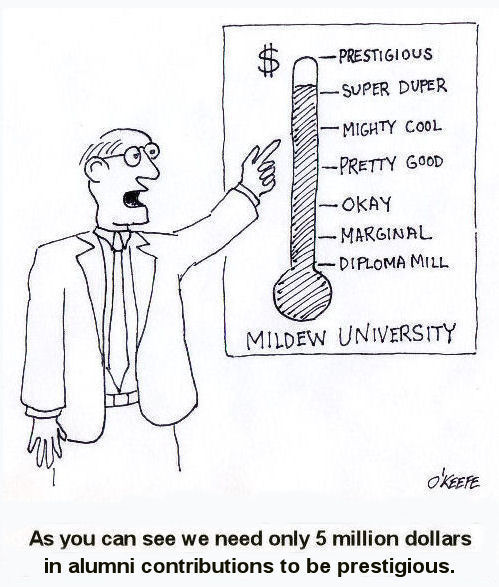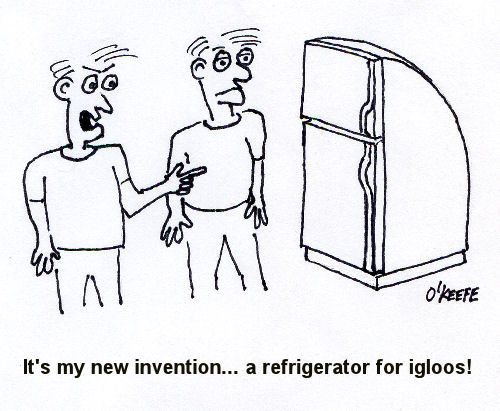|
Your initial response to this question is undoubtedly, “Of course they do!” And your answer would have been formulated through a series of brain functions responsible for logical reasoning skills. The bad news is that logical reasoning skills have no place in the response to this question, at least not according to a recent article and report dated August 19, 2009, by U.S. News & World Report entitled, “America’s Best Colleges 2010.” The report is replete with names of institutions of higher learning which we equate with true excellence in education, names like Harvard, Princeton, the Massachusetts Institute of Technology, and the California Institute of Technology taking the top positions. But was it through a process of logical evaluation and reasoning that these leaders of education once again placed in the Top Ten? Hardly. How they got to the top of the list will surely surprise you. And here it is in a nutshell as taken from the article itself:
So what are the factors used for assessment of America’s top colleges? The first stated criteria is the number graduating within six years. Now call me old fashioned, but I thought a Bachelor’s Degree was traditionally to be earned within four years? And how these graduates perform in the real world is also anyone’s guess because no assessment is offered. This is followed by “retention rates,” meaning the number of students who remain with the institution after one year. If marriages were measured by this yardstick we’d be in real trouble. Then the criteria gets really interesting. Interesting in that its sole focus seems to be on the institution’s financial resources: “…faculty resources, financial resources, student selectivity, and alumni giving account for 75 percent of a college’s score.” “Student selectivity” meaning that institution’s method for selecting its student body. And in case you missed it the first time around, here’s the cherry on top of this massive pile of whipped cream: “The other 25 percent is based on a peer assessment survey…” Hmm, educators assessing other educators. Isn’t that akin to letting the other teenagers in the subdivision decide whether your teen is towing the line within your household or not? Rankings are wonderful tools, if they are based on an objective, unbiased assessment. When it comes to objectively assessing engineers one organization stands head and shoulders above the rest, the National Council of Examiners for Engineering and Surveying (NCEES). It is the same entity responsible for the licensing of Professional Engineers. Here’s what they have to say about their assessment process and objectivity as found through this link: http://www.ncees.org/asd.php
Which assessment process would you trust to hold up your cherry? _________________________________________________________________ au89kp3it2 |
Archive for August, 2009
Experience Vs. Education – The Story of Big Mike
Sunday, August 23rd, 2009|
Big Mike was my father-in-law. His formal education was abruptly stopped at the age of twelve while in the seventh grade when his father met with an untimely death at the wheel of a farm tractor. The place was Europe, and the Great Depression was felt as keenly there as anywhere. Mike became the man of the house then, taking over the running of the farm and providing leadership for his two younger siblings. After the close of World War II, Mike found his way to the Promised Land, the United States of America. He worked a series of unsavory jobs prior to becoming the Chief of Operations Engineering at a prominent hospital near Chicago, jobs such as coal miner and slaughterhouse worker. But he had a knack for all things mechanical, and this is what managed to eventually shine through. Mike landed that good job because someone believed in him. It was a job usually reserved for those with a bona fide education, a BS or MS after their name, earned from a respectable college. Yet without even so much as a grade school diploma to attest to his intelligence, Big Mike was now in charge of others far more educated than he. It was they who held the BS and MS Degrees in Mechanical Engineering, yet they answered to the ingenuity of Big Mike. My father-in-law was not an especially large man physically. That’s not how he earned his name. It was his ability to solve problems and innovate that made him Big in his coworkers’ eyes. For no matter the challenge, Big Mike could always find a way to meet it and resolve it. There was no problem too big for Big Mike. _________________________________________________________________ |
Tech Quiz Number 1
Thursday, August 13th, 2009You Can Make It, But They May Not Buy It
Sunday, August 9th, 2009|
When Thomas A. Edison was a young man in the late 1860s, he made the same mistake that many of today’s novice inventors make: he concentrated all of his efforts on developing and patenting an invention without first doing a thorough market study to see if it had a good chance of being a commercial success. Edison’s first patented invention was a legislative vote recorder (US Patent No. 90,646). The device was surprisingly innovative, enabling legislators to cast their votes in record time. It made the entire voting process far more efficient than the system of roll call voting that was employed at the time. Edison had no doubt that it would be a commercial success. Who in their right mind wouldn’t want something that was efficient and saved time? Pumped full of optimism, Edison took the embodiment of his invention to Washington, D.C. to demonstrate it before a congressional committee. He was shocked to find that no one on the committee was impressed with what he’d done. And to add insult to injury, the Chairman of the committee could not resist saying, “If there is any invention on Earth that we don’t want down here, that is it.” Swallowing his pride, Edison was forced to abandon his invention. If Edison had taken the time to study the market prior to proceeding with his invention, he would have discovered that it would be a foolish waste of time and money to pursue development of the vote recorder past the preliminary concept phase. But the political process was not something he was familiar with, much less the slow pace of roll call voting that Congress employed. He was unaware that this political maneuvering enabled politicians to easily filibuster bills and make deals behind the scenes in order to sway votes. He would find out too late that his was a notion they did not care to support. After his vote recorder demonstration crashed and burned, Edison vowed to only work on inventions that people actually wanted to buy. He ultimately created the world’s first industrial research laboratory that pumped out thousands of inventions that made him a millionaire and created a technological legacy that remains with us today. _________________________________________________________________ |
A Picture Is Worth A Thousand Of Them
Sunday, August 2nd, 2009|
Maybe more? Take the Mona Lisa. Who hasn’t gazed into the eyes of this mysterious female and wondered what she’s thinking, what da Vinci thought as he painted her? And yet, although the questions are many, the image speaks for itself and words seem unnecessary. The mood is clear, the emotional effect visceral. Words would only muddy the waters. And remember the last time you stood in front of an exhibit at the science museum, the one depicting the passage of time since Earth’s formation? Remember that small segment which represented the age when humans were introduced into the mix? Would the words, “humans are thought to have appeared a mere 200,000 years ago, while the Earth is said to be millions of years old,” produce the same effect? Now let’s switch tracks to something less beautiful, yet even more powerful, the photos of a crime scene. There’s a reason those photos are introduced to a jury. The reason has to do with the power of images that transcends all words. Courtroom visual aids introduced to juries in civil cases can be just as powerful. These visual aids could include annotated photographs from a forensic engineering inspection, technical illustrations showing the motion of a complicated mechanism, or scale models that put very large or very small objects into perspective. We live in the Visual Age, there’s no denying it. And studies show that attention spans just keep getting shorter. So the next time you want to get your message across, don’t tell them what you want them to know, show them. Give them something interesting to look at! ____________________________________________________________________ |







